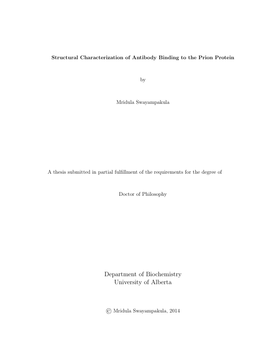This decommissioned ERA site remains active temporarily to support our final migration steps to https://ualberta.scholaris.ca, ERA's new home. All new collections and items, including Spring 2025 theses, are at that site. For assistance, please contact erahelp@ualberta.ca.
- 282 views
- 301 downloads
Structural characterization of antibody binding to the prion protein
-
- Author / Creator
- Swayampakula, Mridula
-
Transmissible Spongiform Encephalopathies (TSEs) are a class of fatal, infectious neurodegenerative disorders affecting the central nervous system. The critical event in the pathogenesis of TSEs is the autocatalytic conformational conversion of the cellular prion protein (PrPC) into an insoluble, β-sheet-rich, toxic isoform (PrPSc). The native PrPC is a GPI anchored glycoprotein with a highly flexible amino-terminal domain and a globular, folded carboxyl-terminal domain with three α-helices and two β-strands. Over the last decade, considerable efforts have been made into developing passive immunity strategies to combat prion diseases and to prevent the harmful conformational conversion of the native PrPC. Our collaborators in Zurich generated the POM monoclonal antibodies with epitopes throughout the recombinant mouse prion protein. The POM1 antibody binds to the globular domain and causes rapid neurotoxicity in cerebellar slices. The POM2 antibody binds to the octapeptide repeats (OR) in the amino-terminal domain and prevents the POM1 induced toxicity. The POM6 antibody is innocuous to the cerbellar slices and competes with the toxic POM1 antibody for binding to the globular domain of the prion protein. This dissertation examines the structural characterization of the two anti-PrP monoclonal antibodies - POM2 and POM6 in complex with their respective epitopes in the mouse prion protein. We successfully report the crystal structure of a tandem OR peptide of PrPC bound to the POM2 Fab that was solved at a resolution of 2.3 Å. It is the first crystal structure that shows the molecular features of an entire OR peptide in its protein bound form. Our structure shows that POM2 Fab uses only back bone and hydrophobic interactions to disrupt the putative β-turn like structure of the unbound octapeptide repeats resulting in their extended conformation. As many OR ligands have been found to show therapeutic potential by delaying the disease onset, the structural study presented in this dissertation makes important contributions to designing smaller and tighter binding OR ligands to improve the efficacy of their binding in vivo. We also successfully report the crystal structure of the mouse PrP125-225 bound to the POM6 Fab that was solved at a resolution of 1.83 Å. The POM6 Fab was found to have epitopes on all the three α-helices of the prion protein. An analysis of the changes in the intra- and inter domain salt bridges and hydrogen bonds in the POM6 bound PrP125-225 in comparison to the wild type PrP shows the formation of new networks of interactions specifically in the β2-α2 loop that may potentially enhance the stability of the POM6 bound PrP. Hence, the POM6 Fab bound PrP molecule may potentially resist prion conversion. A comparison of the toxicity inducing POM1 Fab bound PrP120-231 (PDB ID 4H88) with the innocuous POM6 Fab bound PrP125-225 showed a lack of inter-domain stabilizing salt bridges and hydrogen bonds within the POM1 Fab bound PrP molecule. The comparative analysis between the two Fab- PrP complexes points to vulnerable regions within the prion protein that may influence its aggregation tendencies.
-
- Graduation date
- Fall 2014
-
- Type of Item
- Thesis
-
- Degree
- Doctor of Philosophy
-
- License
- This thesis is made available by the University of Alberta Libraries with permission of the copyright owner solely for non-commercial purposes. This thesis, or any portion thereof, may not otherwise be copied or reproduced without the written consent of the copyright owner, except to the extent permitted by Canadian copyright law.
